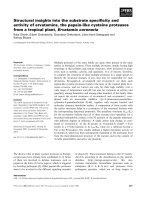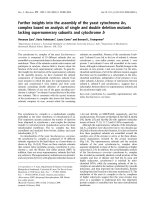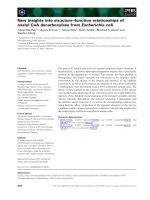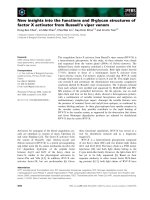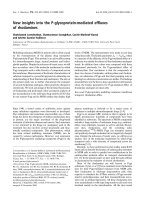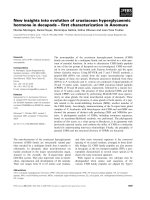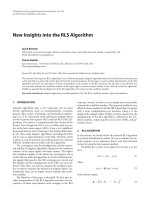Báo cáo y học: "New insights into integrin signalling: implications for rheumatoid arthritis synovial fibroblasts" pptx
Bạn đang xem bản rút gọn của tài liệu. Xem và tải ngay bản đầy đủ của tài liệu tại đây (37.92 KB, 2 trang )
154
ECM = extracellular matrix; FAK = focal adhesion-associated tyrosine kinase; PTP = protein tyrosine phosphatase; RA = rheumatoid arthritis; SF =
synovial fibroblast; Src-PTK = src protein tyrosine kinase.
Arthritis Research & Therapy Vol 5 No 3 Pap
Introduction
Fibronectin is an important component of the articular extra-
cellular matrix (ECM). Both fibronectin itself and fragments
of fibronectin bind to integrin receptors on mesenchymal
cells and exert a variety of effects. Of these, regulation of
cell growth, migration and survival are most prominent.
However, it has also been demonstrated that injection of
fibronectin fragments into joints may cause depletion of pro-
teoglycans [1] and induce the production of matrix degrad-
ing enzymes [2,3]. Binding of fibronectin to integrin
receptors results in the activation of tyrosine phosphoryla-
tion signals, and it is now accepted that the focal adhesion-
associated tyrosine kinase (FAK) plays a central role in this
process. Interactions of FAK with the src family of protein
tyrosine kinases (Src-PTKs) have been described as being
crucial for the initiation of signalling cascades that ultimately
mediate the effects of integrins. Despite this general
concept, early molecular events that regulate the associa-
tion of FAK with Src-PTKs and thus link integrin signalling to
cellular activation are unclear. Specifically, little is known
about the role of receptor protein tyrosine phosphatases
(PTPs), which have been implicated as positive and nega-
tive regulators of integrin signalling.
A recent report from Zeng and coworkers [4] sheds new
light on the involvement of PTPs in early integrin signalling.
Autophosphorylation of FAK at Tyr397 is a key initial step
in the formation of Src-PTK/FAK complexes, which in turn
mediate the phosphorylation of FAK associated proteins.
The establishment of this multi-phosphocomponent sig-
nalling complex appears to be regulated by several intra-
cellular PTPs, one of which is PTP-α. PTP-α can be found
in focal adhesions and is involved in the spreading of cells
on fibronectin. As shown in earlier studies, expression of
PTP-α correlates with Src-PTK activity, and PTP-α acts as
a physiological upstream regulator of Scr-PTKs [5].
Zheng and coworkers [4] compared wild-type, normal
PTP-α
+/+
and PTP-α
–/–
mouse embryonic fibroblasts with
respect to their nonspecific cell migration as well as hap-
totactic migration toward fibronectin. In addition, they ana-
lyzed the effects of PTP-α on integrin-mediated FAK
phosphorylation. Those investigators observed abnormali-
ties of PTP-α
–/–
embryonic fibroblasts in migrating into
space on cell culture dishes. They showed that the migra-
tory defects of PTP-α
–/–
fibroblasts are associated with
altered cell morphology at the leading edge of migrating
cells. These changes are linked to reduced FAK Tyr397
phosphorylation during closure of artificial wounds. Their
finding that the haptotaxis of immortalized embryonic
fibroblasts to fibronectin critically depends on PTP-α is of
special interest. Fibronectin-induced rearrangement of the
cytoskeleton is retarded in PTP-α
–/–
cells, but reintroduc-
tion of PTP-α through adenoviral gene transfer partly
restores the migration of PTP-α
–/–
toward fibronectin.
Although no data on the expression of PTP-α following
gene transfer are presented, the authors suggest that the
lower levels of PTP-α protein in AdPTP-α transduced
PTP-α
–/–
fibroblasts as compared with wild-type PTP-α
+/+
cells are responsible for the incomplete effects of adenovi-
ral delivery of PTP-α. Importantly, fibronectin-induced
association of FAK with Scr-PTKs is reduced also in
PTP-α
–/–
fibroblasts. The association of FAK with Src-
PTKs depends on the autophosphorylation status of FAK.
Therefore, the phosphorylation of FAK at Tyr397 in
PTP-α
–/–
fibroblasts was investigated; FAK Tyr397 phos-
phorylation in response to fibronectin-induced integrin
activation is impaired in the PTP-α
–/–
cells but can be
restored by expression of catalytically active PTP-α. Of
interest, the delay in cell spreading and the altered mor-
phology of PTP-α
–/–
cells were reproduced by addition of
Src-PTK inhibitors.
Based on these data, Zheng and coworkers concluded that
FAK Tyr397 phophorylation is an early event in integrin sig-
nalling and is mediated by PTP-α. Defects in PTP-α activity
result in the impaired formation of Src-PTK/FAK complexes
Viewpoint
New insights into integrin signalling: implications for rheumatoid
arthritis synovial fibroblasts
Thomas Pap
Division of Experimental Rheumatology, University Hospital Magdeburg, Germany, and Center of Experimental Rheumatology, Department of
Rheumatology, University Hospital Zurich, Switzerland
Corresponding author: Thomas Pap (e-mail: )
Received: 23 Mar 2003 Revisions requested: 25 Mar 2003 Revisions received: 28 Mar 2003 Accepted: 28 Mar 2003 Published: 10 Apr 2003
Arthritis Res Ther 2003, 5:154-155 (DOI 10.1186/ar765)
© 2003 BioMed Central Ltd (Print ISSN 1478-6354; Online ISSN 1478-6362)
155
Available online />and affect cytoskeletal rearrangement, cell spreading and
haptotaxis to ECM molecules. However, FAK interacts with
different members of Src-PTK family, and the precise nature
of these interactions requires further investigation. In addi-
tion, the question of how PTP-α acts as an Scr-PTK activa-
tor should now be addressed. Nevertheless, these data
highlight the role played by PTP-α as a key upstream regula-
tor of integrin-mediated signalling, linking ECM signals to
cell migration and Src-FAK signalling.
Integrin-mediated signal transduction is of considerable
interest in a variety of conditions that are associated with
altered attachment of fibroblasts-like cells to ECM. In
rheumatoid arthritis (RA), attachment of synovial fibroblast
to the ECM is an important initiating step in the progres-
sive destruction of articular cartilage [6]. Following early
morphological observations [7], several studies have
established the notion that the invasion of RA synovial
fibroblasts (SFs) into articular cartilage requires their
attachment to the cartilage surface. Integrins have been
identified as important receptors for ECM molecules in
RA, and the increased expression of integrins on RA-SFs
has been associated with their enhanced binding to ECM
[8]. Functional data support the concept that integrin-
mediated signalling events contribute to the invasiveness
of RA-SFs [9]. In addition, cartilage-specific fragments of
fibronectin have been identified as potent activators of
articular chondrocytes [3,10] and fibroblasts [11].
However, little is known about regulation of integrin sig-
nalling in RA-SFs and the relevance of Src-PTK/FAK for-
mation for synovial cell activation. This is in striking
contrast to the multitude of data illustrating the importance
of cytokine-mediated activation, as well as accumulating
evidence for stable alterations in the intracellular signalling
of RA-SFs. Thus, a recent study linked cytokine-mediated
expression of vascular cell adhesion molecule-1 in RA-SFs
to Src-dependent pathways [12], and data have been
reported that suggest that inhibition of Src-PTKs sup-
presses RA-SF proliferation and interleukin-6 production
[13]. In addition, PTEN, a tyrosine phosphatase that inter-
acts with FAK and negatively regulates integrin-mediated
cell spreading, is not expressed in RA-SFs of the most
superficial lining layer and at sites of invasion [14].
It is intriguing to speculate that alterations in Src-PTK/FAK
complex formation are present in RA-SFs, and it is clear
that this aspect of fibroblasts activation requires further
attention. By focusing on cytoskeletal rearrangement and
cell migration, Zeng and coworkers [4] address only part of
the several pathways that have been linked to Src and FAK
signalling and that are of interest for enhancing our under-
standing the complex nature of activated RA-SF behaviour.
This paper, together with data suggesting a role for Src-
FAK signalling in tumour cell metastasis [15], should stimu-
late studies focusing on the role of FAK-mediated
signalling, and specifically the role of PTPs, in RA-SFs.
References
1. Homandberg GA, Meyers R, Williams JM: Intraarticular injection
of fibronectin fragments causes severe depletion of cartilage
proteoglycans in vivo. J Rheumatol 1993, 20:1378-1382.
2. Yasuda T, Shimizu M, Nakagawa T, Julovi SM, Nakamura T: Matrix
metalloproteinase production by COOH-terminal heparin-
binding fibronectin fragment in rheumatoid synovial cells. Lab
Invest 2003, 83:153-162.
3. Yasuda T, Poole AR: A fibronectin fragment induces type II col-
lagen degradation by collagenase through an interleukin-1-
mediated pathway. Arthritis Rheum 2002, 46:138-148.
4. Zeng L, Si X, Yu WP, Le HT, Ng KP, Teng RM, Ryan K, Wang DZ,
Ponniah S, Pallen CJ: PTP
αα
regulates integrin-stimulated FAK
autophosphorylation and cytoskeletal rearrangement in cell
spreading and migration. J Cell Biol 2003, 160:137-146.
5. Su J, Muranjan M, Sap J: Receptor protein tyrosine phos-
phatase alpha activates Src-family kinases and controls inte-
grin-mediated responses in fibroblasts. Curr Biol 1999, 9:
505-511.
6. Pap T, Müller-Ladner U, Gay RE, Gay S: Fibroblast biology. Role
of synovial fibroblasts in the pathogenesis of rheumatoid
arthritis. Arthritis Res 2000, 2:361-367.
7. Fassbender HG: Histomorphological basis of articular carti-
lage destruction in rheumatoid arthritis. Coll Relat Res 1983,
3:141-155.
8. Rinaldi N, Schwarz-Eywill M, Weis D, Leppelmann-Jansen P,
Lukoschek M, Keilholz U, Barth TF: Increased expression of
integrins on fibroblast-like synoviocytes from rheumatoid
arthritis in vitro correlates with enhanced binding to extracel-
lular matrix proteins. Ann Rheum Dis 1997, 56:45-51.
9. Wang AZ, Wang JC, Fisher GW, Diamond HS: Interleukin-
1beta-stimulated invasion of articular cartilage by rheumatoid
synovial fibroblasts is inhibited by antibodies to specific inte-
grin receptors and by collagenase inhibitors. Arthritis Rheum
1997, 40:1298-1307.
10. Arner EC, Tortorella MD: Signal transduction through chondro-
cyte integrin receptors induces matrix metalloproteinase syn-
thesis and synergizes with interleukin-1. Arthritis Rheum 1995,
38:1304-1314.
11. Wang AZ, Zhang XR, Wang JC, Fisher GW, Diamond HS:
Fibronectin induces protease dependent focal matrix deple-
tion and cell overlap in cultured rheumatoid synoviocytes. J
Rheumatol 1995, 22:817-828.
12. Morel JC, Park CC, Zhu K, Kumar P, Ruth JH, Koch AE: Signal
transduction pathways involved in rheumatoid arthritis syn-
ovial fibroblast interleukin-18-induced vascular cell adhesion
molecule-1 expression. J Biol Chem 2002, 277:34679-34691.
13. Takayanagi H, Juji T, Miyazaki T, Iizuka H, Takahashi T, Isshiki M,
Okada M, Tanaka Y, Koshihara Y, Oda H, Kurokawa T, Nakamura
K, Tanaka S: Suppression of arthritic bone destruction by ade-
novirus-mediated csk gene transfer to synoviocytes and
osteoclasts. J Clin Invest 1999, 104:137-146.
14. Pap T, Franz JK, Hummel KM, Jeisy E, Gay RE, Gay S: Activation
of synovial fibroblasts in rheumatoid arthritis: lack of expres-
sion of the tumour suppressor PTEN at sites of invasive
growth and destruction. Arthritis Res 2000, 2:59-65.
15. Hauck CR, Hsia DA, Puente XS, Cheresh DA, Schlaepfer DD:
FRNK blocks v-Src-stimulated invasion and experimental
metastases without effects on cell motility or growth. EMBO J
2002, 21:6289-6302.
Note
This article is based on papers highlighted by Faculty of
1000 ( a web-
based literature awareness service. Faculty of 1000 evalu-
ations available for articles cited in this report may be
viewed on our website at:
Correspondence
Thomas Pap, MD, Division of Experimental Rheumatology, University
Hospital Magdeburg, Leipziger-Str. 44, D-39120 Magdeburg,
Germany. Tel: +49 391 6713314; fax: +49 391 6715447; e-mail:
